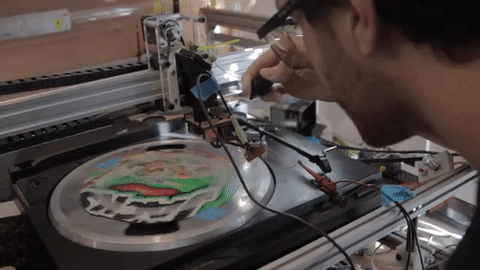How do you like your Ham and Cheese sandwich? If you answered “I prefer it beefy”, look no further than [William Osman]’s Vin Diesel Ham and Cheese Sandwich! [Osman]’s blog tagline is “There’s science to do” but he is the first to admit this is science gone too far. When one of his followers, [Restroom Sounds], commented “Please sculpt a bust of [Vin Diesel] using laser cut cross-sections of laser sliced ham”, he just had to do it.
 His friend [CameraManJohn] modeled the bust using Maya and [Osman] has provided links to download the files in case there’s the remote possibility that someone else wants to try this out. They picked the cheapest packs of sliced ham they could get from the supermarket — so technically, they did not actually laser slice the ham. For help with generating the slice outlines, they found the Slicer app for Autodesk’s Fusion 360 which did exactly what needed to be done. The app converts the 3D model into individual cross sections, similar to an MRI. It helps to measure the thickness of various samples of your raw material so that the Slicer output is not too stretched (or squished). The result is a set of numbered 2D drawings that can be sent to your laser cutter.
His friend [CameraManJohn] modeled the bust using Maya and [Osman] has provided links to download the files in case there’s the remote possibility that someone else wants to try this out. They picked the cheapest packs of sliced ham they could get from the supermarket — so technically, they did not actually laser slice the ham. For help with generating the slice outlines, they found the Slicer app for Autodesk’s Fusion 360 which did exactly what needed to be done. The app converts the 3D model into individual cross sections, similar to an MRI. It helps to measure the thickness of various samples of your raw material so that the Slicer output is not too stretched (or squished). The result is a set of numbered 2D drawings that can be sent to your laser cutter.
The rest of the video scores pretty high on the gross-o-meter, as [Osman] goes about laser cutting slices of ham (and a few slices of cheese), tasting laser cut ham (for Science, of course), and trying to prevent his computer from getting messed up. In the end, the sandwich actually turns out looking quite nice, although we will not comment on its taste. A pair of googly eyes adds character to the bust.
One problem is that the Slicer app does not optimise its results for efficient packing. with the smallest part occupying the same bounding box as the largest. This leads to a lot of wasted pieces of ham slices to be thrown away. [Bill] is still wondering what to do with his awesome sandwich, so if you have suggestions, chime in with your comments after you’ve seen the video linked below. If you know [Vin Diesel], let him know.
This isn’t [Osman]’s first adventure with crazy food hacks — here are a few tasty examples: a Toast-Bot that Butters For You (sometimes), a Laser-Cut Gingerbread Trailer Home, and a Pumpkin-Skinned BattleBot.


















